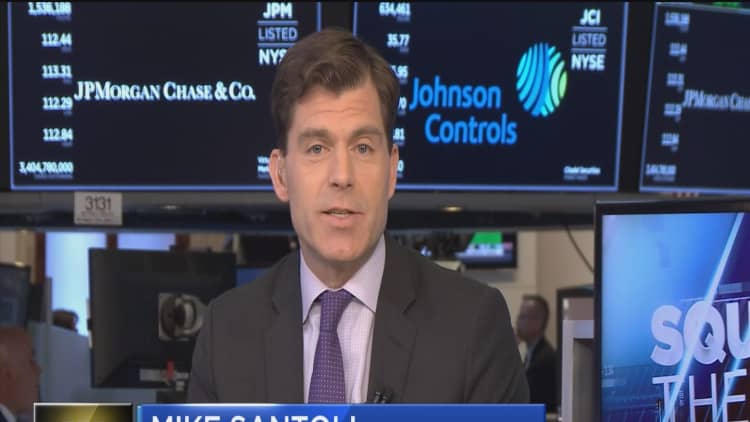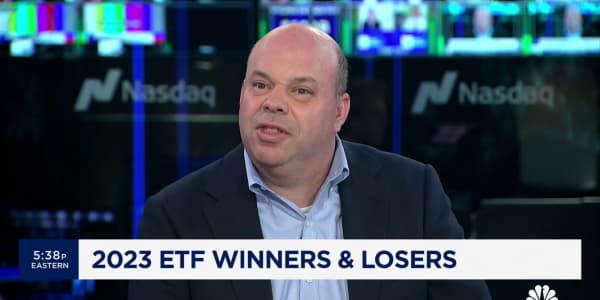
A little more than three months ago I wrote an article saying so-called safe haven stocks aren't so safe. I pointed out that consumer staples stocks, as measured by the XLP — the popular consumer staples tracking ETF — were already off by 6 percent in early March. I take no pleasure in pointing this out, but that ETF is now down by double that percentage.
There are reasons for this:
- Strengthening in the U.S. dollar is making these companies' overseas profits less profitable.
- Interest rates have risen, both on the short and long ends of the yield curve.
The lowest close for the 10-year treasury yield in the past five years was 1.38 percent on July 5, 2016. It's been more than 3 percent lately. The is up over 27.9 percent in that time frame. The strong dollar hurts, but it looks to me like consumer staples are down mainly because of the move up in yields, and it appears to me that it's overdone at this point, for a few of them, at least. It's not only the grocery-store aisle subsector in consumer staples that's been hit hard. AT&T, 3M and Ford are all down year-to-date despite big dividend yields.
When you think of Procter & Gamble, PepsiCo, Kraft Heinz and Kimberly-Clark, you think of safe stock investing, low volatility and healthy dividends. But more importantly, you think of recession-proof investments. People still have to buy toothpaste and toilet paper no matter what the economy does, right? Higher long-term interest rates typically don't signal a recession; they signal economic strength and inflation. That's a recipe that typically favors multiple sectors: industrials, natural resource stocks, financials and technology, some of which are pushing up the major averages this year.
A big change in market: Even 'safe' stocks look too expensive
But there's another issue with consumer staples: These stocks are not cheap. With price-to-earnings ratios at 20x and higher and virtually little to no organic growth, these stocks are more like value stocks at the end of a cyclical bull market, toppy charts with slowing earnings growth.
So maybe the recession-proof thought process needs a reboot, and investors should be rotating out of consumer staples and loading up on cyclical-type stock sectors mentioned above? Not so fast. I realize I'm threading a needle by offering up reasons to go long and avoid consumer staples, but please allow me to finish.
Not even a tech stock like Cisco Systems could avoid the ire of investors when it recently reported earnings growth that was good. Cisco beat on both the top and bottom lines. But in this market, anything short of a big beat from a tech company just won't cut it. The FANG stocks — Facebook, Amazon, Netflix and Google (now Alphabet) — which now also go by the FAANG acronym if you want to add in Apple, are literally holding up the major stock averages. That's the big thing that has changed in the stock market.
Growth stocks need to show FANG-like growth; otherwise, they are deemed too expensive. When other tech companies are crushing expectations by double digits, Cisco's beat was totally underwhelming: with 6.75 percent growth in net income and 4.4 percent revenue growth quarter-over-quarter. And more importantly, at over 20 times earnings, it is not a cheap stock.
Pepsi recently reported a 4 percent rise in earnings, which is considered very healthy for a corporate giant of its type. Four of the mightiest consumer staples companies — P&G, Kimberly-Clark, PepsiCo and Kraft Heinz — can't catch a break, because FAANG has given us a new meaning of growth stock. Nine years into a bull market, only the highest-growth-rate companies can justify ever higher stock prices. In other words, FAANG spoiled us investors by defying the law of large numbers and delivering growth consistently beyond our already lofty expectations.
The most likely catalyst for consumer staples to trade higher would be a perceived slowdown in the economy leading to a takeover boom in the sector. ... Both of those scenarios are on the way.
What should you do with your consumer staples stocks that are down and showing no bottom in sight? Until recently, they were considered growth stocks because in times of recession, people do still buy Doritos and ketchup, in addition to toothpaste and toilet paper. That's still true, of course, and this is a tough one for anyone who believes diversification is important.
My advice is to hold on and don't throw diversification out the window. I wouldn't compare this situation to energy stocks at the beginning of this year — because consumer staples would have to go a lot lower for me to run out and buy a lot more on the dip rather than just hold on to what I've got — but I do think this cohort still has a lot going for it, and adding a little bit at a time is worth considering. That's despite the fact that many of these stocks will probably trade lower over the near term.
The most likely catalyst for consumer staples to trade higher would be a perceived slowdown in the economy leading to a takeover boom in the sector because it is so hard for these companies to grow organically. Both of those scenarios are on the way, in my opinion, but it'll be a good, long while until we get there. Plus, many of these stocks are now paying 4 percent-plus dividend yields and growing their dividends slowly over time.
An underappreciated FANG threat to staples
One last warning: These companies are not in control of their own destinies anymore. With Facebook and Alphabet's Google amassing massive amounts of data and well-developed artificial intelligence to monetize data, they are now acting as the Nielsen ratings for all things we could possibly buy. Now that's not new news, but it is definitely getting bigger at an accelerating rate.
As an example, market research done by a Clorox just doesn't cut it anymore — not when Facebook could tell Clorox, for a price, which of its products are selling well and which ones are not. It was social media that warned consumers that some people were swallowing Tide pods. Had this come up in P&G's market testing, they could have stopped that from happening much sooner.
In the age of information, bigger is better, bigger begets bigger, and lead time becomes a bigger lead time. When a consumer staples company wants to innovate, they turn to social media companies for the consumer-interest information they need.
S&P 500 sector performance year-to-date
| Sector ETF | YTD performance |
|---|---|
| Technology XLK | 9.27% |
| Energy XLE | 7.74% |
| Consumer discretionary XLY | 7.14% |
| Financials XLF | 0.90% |
| Health care | 0.86% |
| Industrials XLI | (-0.28%) |
| Materials (XLB) | (-1.64%) |
| Utilities XLU | (-5.33%) |
| Real estate XLRE | (-5.4%) |
| Consumer staples | (-12.39%) |
| S&P 500 SPY | 2.23% |
Source: Select Sectors SPDRs
This is why when I say consumer staples aren't in charge of their own destiny like they used to be, that has real implications for stock valuation: Their formerly high P/E ratios will be marked down permanently. Companies always have used the data sets they have in order to sell more goods and services to customers, but the data-collecting power of a company like Alphabet, for example, means that no one else can catch up to it.
Consumer staples stocks always have had something basic going for them: a comfort level among retail and institutional investors. This year has delivered a lesson: Owning quality names ain't what it used to be. Understanding that is the first step in figuring out the future of consumer staples stocks and other classic dividend plays in a new interest rate and big tech disruption era.
— By Mitch Goldberg, president of investment advisory firm ClientFirst Strategy





